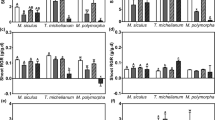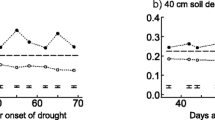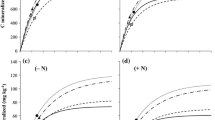Abstract
Poor adoption of sustainable pre-rice green manure technology by lowland farmers is frequently associated with unreliable legume performance under adverse environmental conditions such as marginal soils, short photoperiod, and unfavorable hydrology. A series of field and microplot experiments were conducted at the International Rice Research Institute (IRRI) in 1991 and 1992 to screen and evaluate 12 promising flood-tolerant legumes for adaptation (N accumulation and biological N2 fixation) to a range of environmental stresses, frequently encountered in rice lowlands. Legumes belonging to the genera Sesbania and Aeschynomene were grown for 8 weeks at 10×10 cm spacing: (1) in a fertile control soil and in four marginally productive irrigated lowland rice soils (sandy Entisol, P-deficient Inceptisol, acid Ultisol, and saline Mollisol); (2) during short- (11.7h) and long-day (12.3 h) seasons in a favorable irrigated lowland soil; and (3) in an aerobic soil (drought-prone rain-fed lowland) and a deep-flood-prone lowland soil (1 week seedling submergence). A large variability in N accumulation was obsersed among legume species and across different environments, ranging from less than 1 to over 70 mg N plant-1. The nitrogen derived from the atmosphere (Ndfa) accounted on average for 82% of total N accumulation. Sesbania virgata was least affected by unfavorable soil conditions but its Ndfa was the lowest among the tested species (less than 60%). Stem nodule formation did not convey a significant advantage to legumes grown under adverse soil conditions. However, flooding reduced N2 fixation less in stem-nodulating than in solely root-nodulating species. Most species drastically reduced N accumulation under short-day conditions. Aeschynomene afraspera and S. speciosa were least affected by photoperiod. The considerable genetic variability in the germplasm screened allows the selection of potentially appropriate legumes to most conditions studied, thus increasing N accumulation in green manures.
Similar content being viewed by others
References
Abrol IP, Palaniappan SP (1988) Green manure crops in irrigated and rainfed lowland rice-based cropping systems in South Asia. In: IRRI (ed) Green manure in rice farming. The International Rice Research Institute (IRRI), PO Box 933, Manila, Philippines, pp 83–95
Alazard D, Becker M (1987) Aeschynomene as green manure for rice. Plant and Soil 101:141–143
Ali M, Narciso JH (1994) Economic evaluation and farmer's perception of green manure use in rice-based arming systems. In: Ladha JK, Garrity DP (eds) Green manure production systems in Asian ricelands. The International Rice Research Institute (IRRI), PO Box 933, Manila, Philippines, pp 173–195
Arunin S, Dissataporn C, Anuluxtipan Y, Nana D (1988) Potential of Sesbania as green manure in saline rice soils in Thailand In: RRRI (ed) Green manure in rice farming. The International Rice Research Institute (IRRI), PO Box 933, Manila, Philippines, pp 83–95
Becker M, George T (1995) Nitrogen fixation response of stem-and root-nodulating Sesbania species to flooding and mineral nitrogen. Plant and Soil 175:189–196
Becker M, Ladha JK, Ottow JCG (1990) Growth and nitrogen fixation of two stem-nodulating legumes and their effect as green manure on lowland rice. Soil Biol Biochem 22:1109–1119
Becker M, Diekmann KH, Ladha JK, DeDatta SK, Ottow JCG (1991) Effect of NPK on growth and nitrogen fixation of Sesbania rostrata as a green manure for lowland rice (Oryza sativa L.). Plant and Soil 132:149–158
Becker M, Ladha JK, Ali M (1995) Green manure technology: Potential, usage, limitations. A case study for lowland rice. Plant and soil 174:181–194
Buresh RJ, Austin ER, Craswell ET (1982) Analytical methods in 15N research. Fert Res 3:37–62
Dreyfus BL, Dommergues YR (1980) Non-inhibition de la fixation d'azote par l'azote combine chez une légumineuse à nodules caulinaires, Sesbania rostrata. C R Acad Sci (Paris) 291:767–770
Eaglesham ARJ, Szalay AA (1983) Aerial stem nodules on Aeschynomene. Plant Sci Lett 29:265–272
Engels KA, Becker M, Ottow JCG, Ladha JK (1995) Influence of P and PK fertilization on N2 fixation of the stem-nodulating green manure legume Sesbania rostrata in different marginally productive wetland rice soils. Biol Fertil Soils 20:107–112
Garrity DP, Becker M (1994) Where do green manures fit in Asian rice farming system? In: Ladha JK, Garrity DP (eds), Green manure production systems for Asian ricelands. The International Rice Research Institute (IRRI), PO Box 933, Manila, Philippines, pp 111–129
Ghai SK, Rao DLN, Batra L (1984) Comparative study of the potential of sesbanias for green manuring. Trop Agric (Trinidad) 62:52–56
King FH (1911) Farmers of forty centuries or permanent agriculture in China, Korea and Japan. Rodale Press, Pensylvania
Ladha JK, Pareek RP, Becker M (1992) Stem-nodulating legume-Rhizobium symbiosis and its agronomic use in lowland rice. Adv Soil Sci 20:147–192
N'Doye I, Dreyfus B (1988) N2 fixation by Sesbania rostrata and S. sesban estimated using 15N and total N difference methods. Soi Biol Biochem 20:209–213
Pareek RP, Ladha JK, Watanabe I (1990) Estimation of N2 fixation by Sesbania rostrata and S. cannabina in lowland rice soil by 15N dilution method. Biol Fertil Soils 10:77–88
Pingali PL, Moy PF, Velasco LE (1990), The post-green revolution blues in Asian rice production. IRRI Social Science Division Paper Series No 90-91. The International Rice Research Institute (IRRI), PO Box 933, Manila, Philippines
Singh Y, Khind CS, Singh B (1991) Efficient management of leguminous green manures in wetland rice. Adv Agron 45:135–189
Watanabe I, Roger PA, Ladha JK, Van Hove C (1992) Biofertilizer germplasm collection at IRRI. The International Rice Research Institute, PO Box 933, Manila, Philippines
Author information
Authors and Affiliations
Rights and permissions
About this article
Cite this article
Becker, M., Ladha, J.K. Adaptation of green manure legumes to adverse conditions in rice lowlands. Biol Fertil Soils 23, 243–248 (1996). https://doi.org/10.1007/BF00335951
Received:
Issue Date:
DOI: https://doi.org/10.1007/BF00335951




